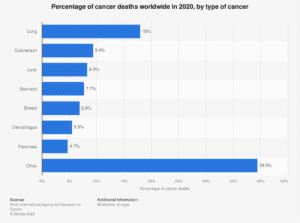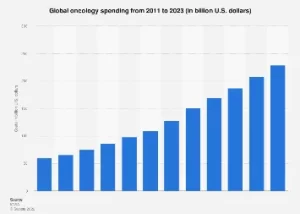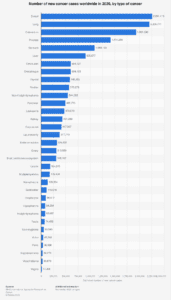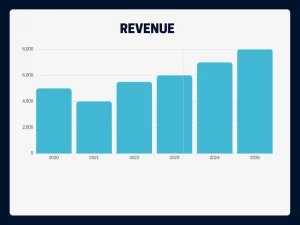- Best PCD Pharma Franchise Company
- +91 9216295095
- hcareindia@gmail.com
Cancer Statistics and Data: What We Know and What We Don’t
Best Feminine Hygiene Wash
Teplizumab, New Molecule in Pharma, Can Delay the Onset of Type-1 Diabetes
Table of Contents
ToggleCancer Statistics and Data: What We Know and What We Don’t
Here are some Cancer Statistic and Data provided. Cancer statistics provide insights into the number of cancer survivors and the projected increase in cancer care costs in the coming years. From the latest global cancer rates to the most common types of cancer affecting men and women, we present this data in an engaging and easily digestible format.
Oncology Drugs is the largest segment of the pharmaceuticals market. Cancer rates are on the rise globally, with the number of new cases expected to increase by 63% by 2040. This trend is a wake-up call for governments, healthcare professionals and individuals to prioritize cancer prevention and control. Every year, approximately 17 million new cancer cases are diagnosed worldwide. This shocking number reminds us of the immense challenges we face in combating this disease and underscores the importance of early detection and prevention strategies.
Cancer knows no age as it is a hidden pandemic with the lesser-known types of cancer that often go undiagnosed until it’s too late.
Cancer (worldwide)
Did you know? Cancer is the second leading cause of death globally, but there are certain countries where it ranks even higher.

Revenue in the Oncology Drugs segment is projected to reach US$188.90bn in 2022. Revenue is expected to show an annual growth rate (CAGR 2022-2027) of 13.84%, resulting in a market volume of US$361.20bn by 2027.
In global comparison, most revenue will be generated in the United States (US$98,100.00m in 2022). In 2020, nearly 10 million deaths were caused by cancer worldwide- a number which is expected to reach over 16 million by 2040. From just under 20 million new cases per year in 2020, to over 30 million new cases per year by 2040, the worldwide cancer incidence rate is projected to increase.
* Revenue (2022)
US$188.90bn
*Revenue Change (2022)
13.2%

Cancer (India)
Revenue in the Oncology Drugs segment is projected to reach US$1.74bn in 2022. Revenue is expected to show an annual growth rate (CAGR 2022-2027) of 14.74%, resulting in a market volume of US$3.46bn by 2027.

*Revenue (2022)
US $ 1.74bn
*Revenue Change (2022)
13.9%
*Type of cancer with the highest number of new cases worldwide in 2020
Breast Cancer
*Type of cancer causing the highest share of cancer deaths worldwide
Lung Cancer
*Global Oncology Spending in 2021
187bn USD
*The region with the highest ovarian cancer incidence rate among women
Papumpare District, West Bengal
*Incidence Rate of Prostate Cancer in Men in Pune
8.1%
*Incidence Rate of Mouth Cancer among Women in Meghalaya
9.5%
*Leading Cancer Site among women in Bangalore
Breast
*Share of Mouth Cancer among Men in Ahmedabad
21.5%
*Share of Breast Cancer among Women in Chennai
32.5%
*City with Leading Cancer Cases among Boys
Aurangabad
*District with Leading Leukemia Incidences among Boys
Thiruvananthapuram
*Incidence Rate of Girls with Leukemia in Manipur
47.7%
Estimated Revenue of Oncology Drugs

In 2021, people between 60 and 64 years old, the prevalence of cancer associated with tobacco use in India was the highest for men and women, at 16.3% and 15.3%, respectively.
In 2016 in India, Kerala had a crude cancer incidence rate of 135.3 incidences per 100,000 inhabitants, making it the state with the most cancer incidences. East India’s Mizoram stood second next at 122 incidences.
Prostate cancer had the highest 5-year survival rate among other cancer types of about 99% between 1996 and 2004 in India. However, colon cancer had the lowest 5-year survival rate in that time period across the country.
Kolkata, West Bengal, had a share of over 20% of lung cancer cases registered among male cancer patients between the years 2012 and 2015.
The second leading type of cancer prevalent among men in that region was prostate cancer with a relative proportion of almost 7%.
According to the World Health Organization, 6.6 million people in the United States alone was diagnosed with cancer in 2022.
That’s approximately one new case of cancer every 41 seconds and one death from cancer every 15 minutes — a grim cancer statistic that reveals an urgent global need for more effective, affordable interventions.
While many different factors are believed to contribute to the rise of cancer statistics rates, especially over the past few decades, it is widely accepted that there is a strong link between our changing environment and the prevalence of this disease.
Lung cancer is the deadliest cancer worldwide, accounting for 1.79 million deaths in 2020. The second most deadly form of cancer is colorectum cancer, followed by stomach and liver cancer.
However, lung cancer is only the sixth leading cause of death worldwide, with heart disease and stroke accounting for the highest share of deaths.
Does cancer differs between gender?
Cancer shows gender disparities with striking differences in cancer prevalence and mortality rates between men and women, highlighting the varied challenges both genders face in their battle against the disease. Lung cancer is the deadliest new cancer worldwide when you look at the cancer statistics on lung cancer incidence among males. Although breast cancer is the most common new cancer in females, it is by far the most common cancer form. While prostate cancer is the most commonly diagnosed cancer in the world, and it is close behind lung cancer in terms of new cases in men.
This cancer statistic describes the percentual distribution of cancer deaths worldwide in 2020, sorted by type of cancer. For both sexes of all ages the total number of cancer deaths was estimated to be approximately 9.95 million in 2020. Almost one fifth of these deaths was from cancer concerning the lung.
Air pollution and cancer risk
Air pollution is one of the most significant environmental causes of cancer, particularly lung cancer. In many studies, exposure to air pollution has been found to increase the risk of lung cancer by as much as 50%. Similarly, the risk of acute myeloid leukemia, a blood cancer, has been found to be increased by nearly 50% in individuals with higher levels of air pollution.
There is also strong evidence that air pollution increases the risk of other cancers as well. For example, studies have found that airborne particles are linked to an elevated risk of bladder, endometrial and kidney cancers. Similarly, cancer can occur due to genetic damage caused by exposure to carcinogenic substances. Exposure to air pollution, then, may increase the risk of cancer by altering our genetic make-up.
Diet and cancer risk
Many cancer statistics have found a strong link between diets high in red meat and processed meat and the risk of developing certain cancers. A diet high in red meat is often associated with a higher risk of colorectal cancer, while a diet high in processed meat is often linked to an increased risk of pancreatic and stomach cancers. These dietary components, however, only account for a small portion of the overall cancer risk.
Majority of a person’s overall cancer risk is determined by genetics. That is, while a diet high in red meat could increase the risk of colorectal cancer by as much as 37%, it could only account for 6% of the overall cancer risk. A healthy diet low in sugary foods, processed meats and refined grains could help reduce your risk of developing diabetes and other diet-related diseases. Healthy diet is believed to reduce the risk of developing type 2 diabetes, a disease that is strongly linked to an elevated risk of many cancers. For example, zinc is an important nutrient that is believed to play a key role in protecting against the development of certain cancers, including prostate, breast and colon cancers. Similarly, vitamins C and E are believed to play a key role in preventing DNA damage.
UV rays and skin cancer risk
UV rays are among the most significant environmental causes of skin cancer, particularly basal and squamous cell carcinomas. Other forms of skin cancer, including melanoma and Bowen’s disease, can also be caused by UV exposure, but are much rarer.
A large number of studies on cancer statistics have found that people with a history of skin cancer are more likely to develop non-melanoma skin cancers, including basal cell and squamous cell carcinomas, if they frequently expose their skin to UV rays. People with a high risk of developing skin cancer who regularly go outside during the middle of the day are especially at risk. Exposure to UV rays is also associated with an elevated risk of a number of other cancers, including liver and kidney cancers, as well as prostate cancer.
Fortunately, there are many ways to protect your skin from the harmful effects of UV rays. For example, wearing sunscreen when you go outside and staying inside when the UV index is high can significantly reduce your cancer risk. Keeping your skin well-hydrated by applying sunscreen several times per day and avoiding excessive sweating can help prevent skin damage.
Occupational safety aspects of cancer risk
Occupational health and safety professionals often discuss the preventative measures that can be taken to minimize the risk of occupational cancer.
These include regularly wearing protective equipment such as masks, gloves and goggles, and limiting your work duration to the maximum allowable hours allowed by law.
As with dietary and environmental factors, however, the major cancer-related risk is determined by genetics. That is, you can take all the right precautions and make all the right lifestyle changes and still develop cancer.
The only way to significantly lower your risk of cancer is by avoiding risks that are caused by your own genes.
Physical activity and body weight
There is some evidence to suggest that physical activity can reduce the risk of certain cancers, such as colorectal and esophageal cancers, and heart disease. However, there is also some cancer statistic evidence to suggest that a physically-intense lifestyle may be problematic for some people. For example, some studies have found that physically-intense athletes have an increased risk of dying from cancer compared to people who are less physically active.
These findings suggest that there is a balance that must be struck between an active and a sedentary lifestyle. While physical activity can help reduce your risk of certain types of cancer, it cannot prevent cancer completely. Instead, it can slow down the rate at which cancer develops while you are still alive.
Conclusion
Cancer is a complex disease that cannot be fully prevented by changing your diet, avoiding UV rays, or being physically active. Instead, your risk of developing cancer is determined by your genetics.
The only way to significantly lower your risk of cancer is by avoiding risks that can harm your own genes.
The global burden of cancer is increasing at an alarming rate. According to the World Health Organization, cancer is the second leading cause of death.
While it is difficult to provide a complete picture on the worldwide prevalence of this disease, new research and initiatives are emerging that provide insight into its causes and implications.
This article highlights some of the key trends in the epidemiology of cancer as well as potential solutions being explored.
Note
*This text provides general information. H & Care Incorp assumes no liability for the information given being complete or correct.
Also go through Adagrasib, an Antineoplastic Drug, New Molecule in Pharma and Data of Pharmaceutical Sector Growth up to 2030
